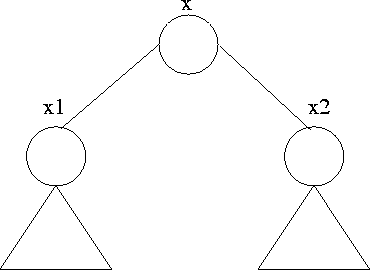 |
In a RBT, no path from a node x to a leaf is more than twice as long as any other path from x to a leaf.
Let bh(x) be the black height of x. Then the length of a longest path from x to a leaf
= 2bh(x) {a path on which red and black nodes alternate}
Length of the shortest possible path from x to a leaf
bh(x) {a path that only contains blacks}
Hence the result.
Result 2
A red-black tree with n internal nodes has height at most
2log(n + 1)
Consider any node x and the subtree rooted at x. We will first show that this subtree has at least
2bh(x) - 1 internal nodes
We do this by induction on the height of x. If h(x) = 0, bh(x)
= 0, x is leaf and hence the subtree has no internal nodes, as corroborated
by
20 - 1 = 0
Let h(x) > 0 and let x1 and x2 be its two children (Figure 5.11)
 |
Note that h(x1), h(x2) are both ![]() h(x)
- 1. Assume the result to be true for
x1 and x2. We shall show the result
is true for x.
h(x)
- 1. Assume the result to be true for
x1 and x2. We shall show the result
is true for x.
Now,
| bh(x1) | bh(x) and |
||
| bh(x2) | bh(x) and |
Therefore, the tree with root x1 has at least
![]() 2bh(x)
- 1 - 1
2bh(x)
- 1 - 1![]() internal nodes
internal nodes
whereas the tree with root x2 has at least
![]() 2bh(x)
- 1 - 1
2bh(x)
- 1 - 1![]() internal nodes
internal nodes
Thus the tree with root x has at least
1 + 2bh(x) - 1 - 1 + 2bh(x) - 1 - 1 = ![]() 2bh(x)
- 1
2bh(x)
- 1![]()
![]() internal nodes
internal nodes
To complete the proof, let h be the height of the tree. Then
bh (root) ![]()
![]()
Thus
| n/TD> | 2h/2 - 1 | ||
| 2log(n + 1) |